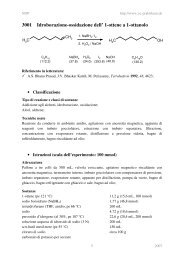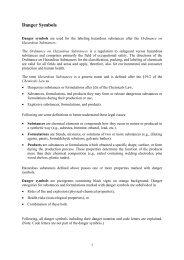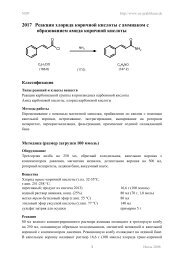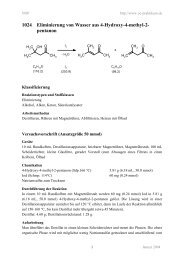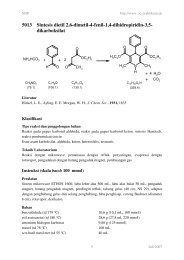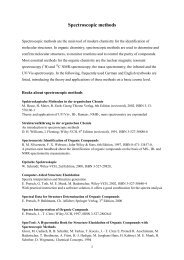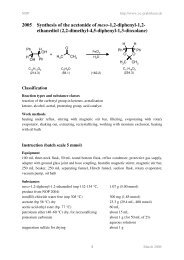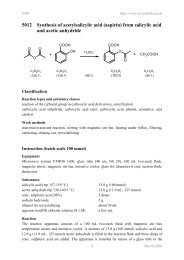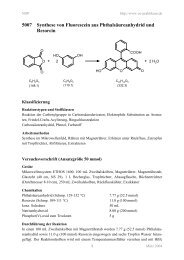Synthesis instructions as PDF file for printing - kriemhild
Synthesis instructions as PDF file for printing - kriemhild
Synthesis instructions as PDF file for printing - kriemhild
Create successful ePaper yourself
Turn your PDF publications into a flip-book with our unique Google optimized e-Paper software.
NOP http://www.oc-praktikum.de<br />
5004 Acid catalyzed acetalisation of 3-nitrobenzaldehyde with<br />
ethanediol to the correspondent 1,3-dioxolane<br />
H<br />
O<br />
NO 2<br />
Cl<strong>as</strong>sification<br />
+<br />
HO<br />
HO<br />
Reaction types and substance cl<strong>as</strong>ses<br />
reaction of the carbonyl group in aldehydes, acetalisation<br />
aldehyde, acetal, alcohol, protecting group, acid catalyst<br />
Work methods<br />
microwave-<strong>as</strong>sisted reaction, stirring with magnetic stir bar, heating under reflux, distillation,<br />
introduction of g<strong>as</strong>, shaking out, extracting, evaporating with rotary evaporator, filtering,<br />
recrystallizing<br />
Instruction (batch scale 100 mmol)<br />
4-toluenesulfonic acid<br />
C 7 H 5 NO 3 C 2 H 6 O 2 C 7 H 8 O 3 S . H 2 O C 9 H 9 NO 4<br />
(151.1) (62.1) (190.2) (195.2)<br />
Equipment<br />
microwave heating system ETHOS 1600, 100 mL three-neck fl<strong>as</strong>k, distillation apparatus, 100<br />
mL round-bottom fl<strong>as</strong>k, bubble counter, adapter with ground-gl<strong>as</strong>s joint and hose coupling,<br />
250 mL two-neck fl<strong>as</strong>k, reflux condenser, 250 mL round-bottom fl<strong>as</strong>k, magnetic stirrer with<br />
magnetic stir bar, rotary evaporator, suction fl<strong>as</strong>k, suction filter, separating funnel, desiccator,<br />
gl<strong>as</strong>s connecting pipe (NS 29, 40 cm),<br />
Substances<br />
3-nitrobenzaldehyde (mp 58 °C; product from 15.1 g (100 mmol)<br />
NOP-Nr. 1003)<br />
ethanediol (bp 198 °C) 9.32 g (8.4 mL, 150 mmol)<br />
4-toluenesulfonic acid monohydrate (mp 103-105 °C) 1.0 g (5.3 mmol)<br />
tert-butyl methyl ether (bp 55 °C) 240 mL<br />
petroleum ether (bp 40-60 °C) 70 mL<br />
sodium sulfate <strong>for</strong> drying etwa 15 g<br />
sodium disulfite about 13 g (<strong>for</strong> 20 mL saturated<br />
aqueous NaHSO3-solution)<br />
1<br />
O<br />
O<br />
+<br />
NO 2<br />
O<br />
H 2<br />
July 2005
NOP http://www.oc-praktikum.de<br />
Reaction<br />
For the set up of the reaction apparatus in the microwave see:<br />
“Technical <strong>instructions</strong>. Standard refluxing apparatus <strong>for</strong> microwave systems”.<br />
The used apparatus, compared to the standard refluxing apparatus, is slightly modified: A<br />
three-neck round-bottom fl<strong>as</strong>k is used instead of a two-neck round-bottom fl<strong>as</strong>k, and the<br />
reflux condenser is exchanged with a distillation bridge with a collection round-bottom fl<strong>as</strong>k.<br />
A temperature sensor is placed into one of the side openings in the three-neck round-bottom<br />
fl<strong>as</strong>k. In the second side opening a PTFE tube is connected via a ground gl<strong>as</strong>s joint adapter.<br />
This tube p<strong>as</strong>ses through an opening in the microwave system and is connected to a bubble<br />
counter and a stop-cock that is connected to the air pressure or nitrogen line. The flow rate of<br />
the cooling water in the distillation bridge can be reduced to a minimum during the course of<br />
the experiment. The stop-cock is closed to begin with.<br />
Picture 1: Three-neck round-bottom fl<strong>as</strong>k with<br />
g<strong>as</strong> inlet and fibre optic temperature sensor<br />
2<br />
Picture 2: Distillation bridge <strong>as</strong> add on to<br />
the gl<strong>as</strong>s connecting tube<br />
15.1 g (100 mmol) 3-nitrobenzaldehyde, 9.32 g (8.4 mL, 150 mmol) ethanediol and 1.0 g (5.3<br />
mmol) p-toluenesulfonic acid monohydrate are placed in a 100 mL three-neck round-bottom<br />
fl<strong>as</strong>k fitted with a stir bar or a cross stirrer. The reaction mixture is irradiated <strong>for</strong> 50 minutes<br />
with 900 W at a set temperature of 130 °C.<br />
The stop-cock remains closed during the first 25 minutes. Thereby a weak reflux is<br />
established in the gl<strong>as</strong>s connecting tube. The volatile components of the reaction mixture are<br />
mainly water and ethanediol. As the absorption of the microwaves in the g<strong>as</strong> ph<strong>as</strong>e is much<br />
less than in the liquid ph<strong>as</strong>e, neither water nor ethanediol is distilled over.<br />
July 2005
NOP http://www.oc-praktikum.de<br />
After 25 minutes reaction time under reflux whilst the microwave program continues to run,<br />
an air or nitrogen flow is introduced with such a flow rate that no single g<strong>as</strong> bubbles are<br />
visible in the bubble counter (if a flow rate meter is present, 5 L/h). A mixture (3-8 mL) of<br />
water, ethanediol and small amounts of product are collected in the collection round-bottom<br />
fl<strong>as</strong>k.<br />
Work up<br />
Once the program is completed, the reaction fl<strong>as</strong>k is placed in a water bath and the oily<br />
contents, which tends to crystallization, is allowed to stir <strong>for</strong> 5 minutes. One then adds 80 mL<br />
water and allows to stir intensively <strong>for</strong> a further 15 minutes. The water is separated from the<br />
ivory coloured solid product with a folded filter paper. The crystallized product traces in the<br />
condenser and in the collection round-bottom fl<strong>as</strong>k are also rinsed out with water and filtered.<br />
Yield of crude product: 18.6 g; mp 50-52 °C; purity according to GC 98%<br />
In order to remove the not converted aldehyde with sodium hydrogensulfite, the crude product<br />
(which can still be wet) is dissolved in 200 mL tert-butyl methyl ether and extracted with<br />
20 mL saturated aqueous sodium hydrogen sulfite solution. The organic ph<strong>as</strong>e is dried over<br />
sodium sulfate. Once the drying agent h<strong>as</strong> been filtered off, the solvent is completely<br />
evaporated on the rotary evaporator with a bath temperature of 40 °C. The bath temperature<br />
should not be higher due to the low melting point of the product. A pale yellow, fine<br />
crystalline solid remains.<br />
Yield: 17.7 g (90.7 mmol, 91%); mp 52-54 °C; purity according to GC 99.8%<br />
The product can be recrystallized from a solvent mixture of tert-butyl methyl ether/petroleum<br />
ether: The product is placed into a 250 mL two-neck round-bottom fl<strong>as</strong>k contanining a<br />
magnetic stir bar. A solvent mixture of 40 mL tert-butyl methyl ether and 50 mL petroleum<br />
ether (40-60 °C) is added. The fl<strong>as</strong>k is set up in the microwave, <strong>as</strong> described <strong>for</strong> the standard<br />
reflux apparatus, and allowed to stir under reflux <strong>for</strong> 2 minutes at 500 W and 55 °C. The clear<br />
solution is cooled in a water bath during the 5 minute ventilation period in the microwave.<br />
The semi-solid crystalline slurry is then allowed to stand <strong>for</strong> at le<strong>as</strong>t a further 15 minutes at<br />
room temperature and then a further 1 hour in the refrigerator. The crystals are filtered off<br />
using a suction filter. The crystallization fl<strong>as</strong>k is w<strong>as</strong>hed 2 times with 10 mL petroleum ether,<br />
thereby w<strong>as</strong>hing the residue onto the filter. The recrystallized product is dried in the<br />
desiccator at reduced pressure.<br />
Yield of recrystallized product: 16.4 g (84.0 mmol, 84%); mp 53-55 °C<br />
After evaporating the solvent of the mother liquor from the recrystallization, a residue of<br />
1.2 g, consisting of 95 % product, is obtained.<br />
Comments<br />
If the reaction is per<strong>for</strong>med only under reflux, but without distilling off the volatile<br />
substances, less than 90 % of the 3-nitrobenzaldehyde is converted to the acetal. Together<br />
with condensing water also some ethanediol is distilled off <strong>as</strong> an azeotrope.<br />
By stirring the reaction mixture with water possible residues of ethanediol and p-toluenesulfonic<br />
acid are removed.<br />
3<br />
July 2005
NOP http://www.oc-praktikum.de<br />
During recrystallization the cooling water bath prevents the rele<strong>as</strong>e of hot solvent vapors from<br />
the product solution, when the fl<strong>as</strong>k is removed from the microwave oven.<br />
W<strong>as</strong>te management<br />
Recycling<br />
The tert-butyl methyl ether evaporated during the work up of the crude product can be used<br />
<strong>for</strong> the recrystallization. The leftover ether is collected and redistilled.<br />
W<strong>as</strong>te disposal<br />
W<strong>as</strong>te Disposal<br />
aqueous ph<strong>as</strong>es solvent water mixtures, halogen free<br />
mother liquor from recrystallization organic solvents, halogen free<br />
sodium sulfate solid w<strong>as</strong>te, free from mercury<br />
Time<br />
Isolation of the crude product 2 hours<br />
Work up to the pure product 1 hour<br />
Recrystallization with drying about 2 hours<br />
Break<br />
After stirring the reaction mixture with water<br />
Degree of difficulty<br />
Medium<br />
4<br />
July 2005
NOP http://www.oc-praktikum.de<br />
Analytics<br />
Temperature-time-dependence of the synthesis in the microwave<br />
Temperatur [°C]<br />
160<br />
140<br />
120<br />
100<br />
80<br />
60<br />
40<br />
20<br />
0<br />
Temperatur [°C]<br />
Leistung [W]<br />
0 500 1000 1500 2000 2500 3000 3500<br />
Zeit [sec]<br />
Temperature-time-dependence of the recrystallization in the microwave<br />
Temperatur [°C]<br />
60<br />
50<br />
40<br />
30<br />
20<br />
10<br />
0<br />
0<br />
0 50 100 150 200 250 300 350 400 450 500<br />
Reaction monitoring by GC<br />
Zeit [sec]<br />
Temperatur [°C]<br />
Leistung [W]<br />
Sample preparation: Of each sample, 20 mg are dissolved in 0.5 mL ethyl acetate. 3 µL of the solution is<br />
injected.<br />
For the analysis of the extracted product, 3 µL tert-butyl methyl ether solution can be<br />
injected.<br />
GC conditions:<br />
column: HP-5; L=30 m,d=0.32 mm, film=0.25 µm (Phenomenex)<br />
inlet: split injection 194:1<br />
carrier g<strong>as</strong>: H2, precolumn pressure 31 kPa<br />
oven: 50 °C, 8 °C/min 320 °C<br />
detector: 300 °C<br />
5<br />
1000<br />
900<br />
800<br />
700<br />
600<br />
500<br />
400<br />
300<br />
200<br />
100<br />
0<br />
600<br />
500<br />
400<br />
300<br />
200<br />
100<br />
Leistung [W]<br />
July 2005
NOP http://www.oc-praktikum.de<br />
Percent concentration w<strong>as</strong> calculated from peak are<strong>as</strong><br />
GC of the crude product<br />
Retention time (min) Substance Peak area %<br />
1.7 educt (ethanediol) 0.7<br />
13.5 educt (3-nitrobenzaldehyde) 1.0<br />
18.5 product (1,3-dioxolane) 98.3<br />
GC of the product (after extraction with sodium hydrogensulfite solution)<br />
Peak area %: 99.8 % product<br />
GC of the pure product (after recrystallization)<br />
Peak area %: 100 % product<br />
GC of the residue of the mother liquor (from recrystallization)<br />
Peak area %: 95 % product, 5 % not identified<br />
6<br />
July 2005
NOP http://www.oc-praktikum.de<br />
1 H NMR spectrum of the product (200 MHz, CDCl3)<br />
8<br />
7<br />
6<br />
5<br />
(ppm)<br />
δ (ppm) Multiplicity Number of H Assignment<br />
8.37 - 8.35 m 1 2-H<br />
8.25 - 8.20 m 1 4-H<br />
7.83 - 7.79 m 1 6-H<br />
7.60 - 7.54 m 1 5-H<br />
5.90 s 1 7-H<br />
4.18 - 4.05 m 4 8-H<br />
1.55 water<br />
7.26 solvent<br />
13 C NMR spectrum of the product (300 MHz, CDCl3)<br />
150<br />
140<br />
130<br />
120<br />
(ppm)<br />
δ (ppm) Assignment<br />
65.5 – O – CH2 – CH2 – O –<br />
102.3 – O – CH – O –<br />
121.7 CH arene<br />
124.0 CH arene<br />
129.4 CH arene<br />
132.7 CH arene<br />
140.4 C – CH(dioxolane) arene<br />
148.3 C – NO2 arene<br />
76.5-77.5 solvent<br />
110<br />
4<br />
100<br />
90<br />
3<br />
7<br />
80<br />
2<br />
70<br />
1<br />
60<br />
6<br />
5<br />
8 8<br />
O<br />
7<br />
4<br />
1<br />
O<br />
2<br />
3<br />
NO2 July 2005
NOP http://www.oc-praktikum.de<br />
IR spectrum of the product (KBr)<br />
%T<br />
17,9<br />
17<br />
16<br />
15<br />
14<br />
13<br />
12<br />
11<br />
10<br />
9<br />
8<br />
7<br />
6<br />
5<br />
4,4<br />
4000,0 3000 2000 1500 1000 400,0<br />
cm-1<br />
(cm -1 ) Assignment<br />
3093 C – H – valence, arene<br />
2978, 2905, 2862 C – H – valence, alkane<br />
2769 C – H – valence, O – CH – O<br />
1621, 1588 C = C – valence, arene<br />
1532, 1359 N = O – valence, <strong>as</strong>ymm. and symm.<br />
8<br />
July 2005



